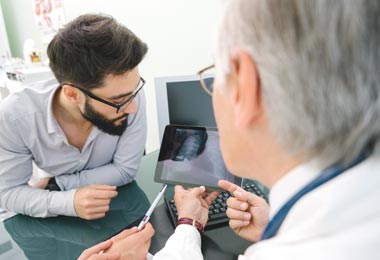Smoking and Respiratory Diseases
Facts about smoking and respiratory diseases
According to the Centers for Disease Control and Prevention (CDC), diseases caused by smoking kill more than 480,000 people in the U.S. each year. In fact, smoking is directly responsible for almost 90% of lung cancer and COPD deaths. Even with antismoking campaigns and health warnings, many people continue to smoke or start to smoke every year. About 8% of kids under age 18 are current tobacco users.
What are the risks linked to smoking?
Smokers increase their risk of lung disease, including lung cancer. But they also increase their risk of other illnesses such as heart disease, stroke, and mouth (oral) cancer. Risks from smoking, as they relate to lung disease, include the following:
Chronic obstructive pulmonary disease (COPD). This includes:
-
Chronic bronchitis. This is a long-term (chronic) inflammation of the large airways (bronchi). Symptoms include coughing mucus over a long period.
-
Emphysema. This chronic lung condition affects the air sacs (alveoli) in the lungs. Symptoms include shortness of breath, coughing, fatigue, sleep and heart problems, weight loss, and depression.
Lung cancer. This is an abnormal growth of cells that can result in lumps, masses, or tumors. It may start in the lining of the bronchi, or other areas of the respiratory system. Smoking, including secondhand smoke, is the leading cause of lung cancer. Symptoms of lung cancer include:
-
Cough
-
Chest pain
-
Shortness of breath
-
Wheezing
-
Recurring lung infections
-
Bloody or rust-colored sputum
-
Hoarseness
-
Swelling of the neck and face
-
Pain and weakness in the shoulders, arms, or hands
-
Unexplained fever
Other cancers. Smoking increases the risk of lung and oral cancer. But it also increases the risk of other respiratory system cancers. These include cancer of the nose, sinuses, voice box, and throat. Smoking also increases the risk of many other cancers of GI (gastrointestinal), urinary, and female reproductive systems.
The symptoms of smoking-related lung diseases may look like other lung conditions or health problems. If you have any symptoms of lung disease, see your healthcare provider as soon as possible.
How dangerous is secondhand smoke?
Secondhand smoke is smoke that is exhaled by smokers and smoke emitted from the burning end of a lit cigarette, cigar, or pipe. It causes more than 7,000 lung cancer deaths each year in people who don’t smoke. It can also lead to lung conditions and heart disease. Symptoms linked to secondhand smoke exposure may include:
-
Eye, nose, and throat irritation
-
Coughing
-
Too much mucus in the airways
-
Chest discomfort or pain
Children and infants exposed to tobacco smoke are more likely to experience ear infections, and asthma. They are also at a higher risk for sudden infant death syndrome (SIDS) than children and infants not exposed to secondhand smoke.
What are the benefits of quitting smoking?
People who quit smoking can actually reverse some of the lung damage. Other benefits of quitting smoking may include the following:
-
Decreased risk for lung disease
-
Decreased risk for heart disease
-
Decreased risk for cancer
-
Reduced cigarette stains on fingers and teeth
-
Reduced occurrence of cough
-
Elimination of stale cigarettes smell on clothing and hair
-
Improved smell and taste
-
Saving money by not buying cigarettes
How does cigar smoking affect a person's risk of lung cancer and other types of cancer?
Cigars actually pose the same, if not greater, risk as cigarettes for oral cancer. Although many cigar smokers do not inhale, their risk for oral, throat, and esophageal cancers is the same as for cigarette smokers. Consider these facts from the CDC:
-
Compared with nonsmokers, cigar smokers who inhale are more likely to develop oral cancer, esophageal cancer, and laryngeal cancer.
-
Cigar smokers who inhale and smoke 5cigars a day may have a lung cancer risk similar to one-pack-a-day cigarette smokers.
-
Secondhand smoke from cigars contains toxins and cancer-causing agents (carcinogens) similar to secondhand cigarette smoke, but in higher concentrations.
How do people stop smoking?
Quitting smoking is very difficult. The following tips can help you quit using tobacco products:
-
Think about why you want to quit. Make a list of the reasons.
-
Set a quit date.
-
Try to pick a time when you have as little stress as possible.
-
Ask for support and encouragement from family, friends, and coworkers.
-
If you don't already exercise, start to increase your physical activity to improve your health.
-
Try to get enough sleep each night and eat healthy. Along with exercise, healthy sleeping and eating habits will help you cope with quitting.
-
Join a smoking cessation program or support group. These programs are available in most communities. There are also programs available by phone and online:
-
Try the Smokefree.gov website.
-
Try your state's quitline. Call 800-QUIT-NOW (800-784-8669).
-
Medicines to help you stop smoking
There are both prescription and over-the-counter medicines that can help you stop smoking. Talk with your healthcare provider about these medicines and whether or not any of them are right for you.
Over-the-counter medicines:
-
Nicotine patch. Nicotine is delivered through the skin.
-
Nicotine gum. Gum delivers nicotine quickly.
-
Nicotine lozenge. Lozenges are like hard candy.
Prescription medicines:
-
Nicotine nasal spray. Nicotine is also delivered quickly.
-
Nicotine inhaler. Using an inhaler is like smoking cigarettes.
-
Antidepressant medicine (bupropion). It helps to lessen cravings for nicotine.
-
Varenicline tartrate. It helps to lessen the discomfort of quitting. It also lessens the pleasure you get from smoking.



